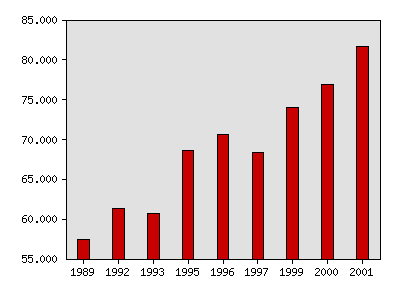What were things like in 2002?
The following idicator summary is from the 2002 Minnesota Milestones and does not neccessarily reflect the current data trends.
Indicator : On-time immunization
Rationale: On-time immunization is an important element in developing healthy children who can attend school every day, ready to learn.
About this indicator: On-time immunization for two-year-olds has risen steadily in the past decade, from 57.4 percent in 1988-89 to 81.7 percent in 2000-2001, an improvement of 24.3 percentage points. Yet even with 81.7 percent coverage in 2000-2001, 12,000 children were not up to date with immunizations at age two.
Immunization is particularly important during the first two years of life when children are most vulnerable to complications from disease. Timely immunization protects children against illness, disability and death from the infectious diseases of hepatitis, diphtheria, tetanus, polio, measles, mumps, rubella, pertussis, influenza and varicella (chickenpox). It is also an indicator of whether children are receiving regular well-child checkups.
Immunization records are collected from parents when children enter school; 2000-2001 data is for children born between 1994 and 1995. Thus the impact of any recent improvement is yet to be measured.
The Minnesota Department of Health goal for the year 2004 is for at least 90 percent of children to receive timely immunization against the 10 diseases mentioned above.
Percentage of kindergartners who were adequately immunized at age two

Percentage of kindergartners who were adequately immunized at age two
| Year | Data |
|---|
| Percentage of kindergartners who were adequately immunized at age two, Minnesota Department of Health
|
|
1989 |
57.4% |
|
1992 |
61.4% |
|
1993 |
60.7% |
|
1995 |
68.6% |
|
1996 |
70.6% |
|
1997 |
68.4% |
|
1999 |
74% |
|
2000 |
76.9% |
|
2001 |
81.7% |
For comparison: According to the 2000-2001 National Immunization Survey, conducted by the U.S. Centers for Disease Control and Prevention, the immunization rate for Minnesota children is between two to four percentage points higher than national figures, for most major diseases.
Things to think about: Coverage is uneven across the state. In some ZIP codes in both urban and rural areas, almost half the children did not receive recommended immunizations on time. The data indicates that, although most Minnesota children start receiving immunizations at 4 months, many fall behind schedule and catch up only when it is time to start school. Immunization rates for varicella continue to lag behind those for the other target diseases.
In 1997, just 69 percent of Minneapolis public school students were up to date on their immunizations. The "No shots, no school" project was implemented that year and now over 98 percent of new and current students are properly immunized. Eighteen other Minnesota school districts now replicate this project.
Technical notes: Parents of children entering kindergarten must provide immunization records showing their children are in compliance with Minnesota's school immunization law. The data, therefore, is retrospective, based on immunizations given during the first two years of life. The data presented in Minnesota Milestones 2002 is based on random samples of schools, except for 1992-3 and 1996-7, when there were comprehensive surveys examining all kindergartners in the state.
Sources:
Minnesota Department of Health, Acute Disease Prevention Services, Retrospective Kindergarten Survey, www.health.state.mn.us
Minnesota Department of Health, Healthy Minnesotans: Minnesota Public Health Improvement Goals, June 1998
U.S. Centers for Disease Control and Prevention, National Immunization Survey, www.cdc.gov
Related 2002 Milestones indicator:
Local data:
County level data:


Milestones is a product of the Minnesota State Demographic Center, a division of the Department of Administration






